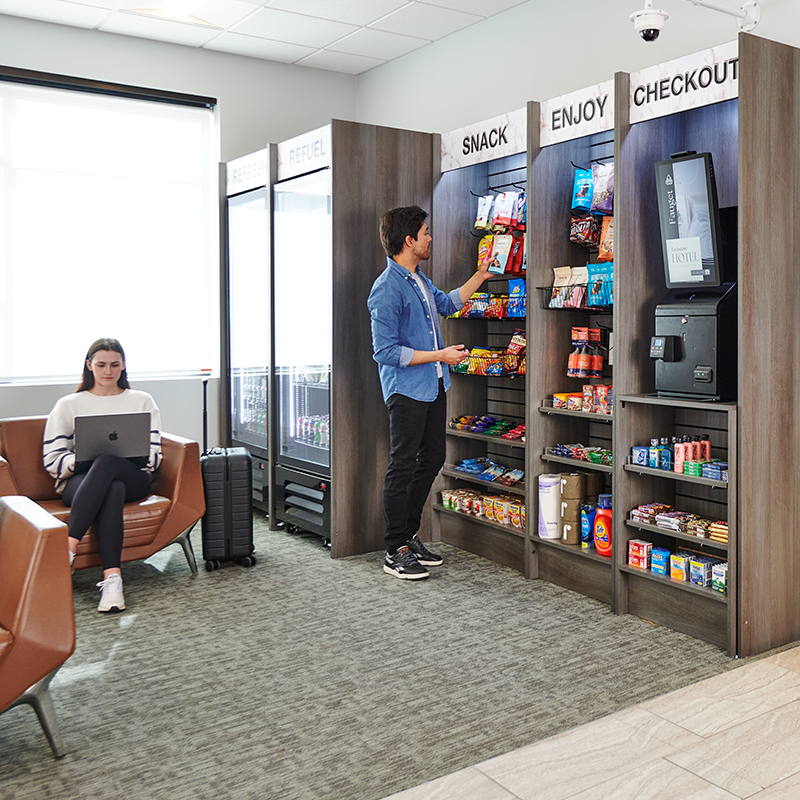Micro markets have revolutionized the vending industry, offering a convenient and diverse shopping experience. According to our research, micro markets accounted for over $756 million in sales and over 300 million transactions in 2023. Micro markets have traditionally been associated with office buildings and hospitals, providing employees and visitors with a convenient way to access snacks and meals.
However, micro markets are expanding rapidly — the number of micro market locations increased by 36% over 2023. But with many businesses moving away from a fully in-person work model, new micro markets need to go where the people are. Let’s dive into three alternative locations that are perfect for micro markets.
Luxury Apartment Buildings
Luxury apartment buildings are a prime location for micro markets. With residents seeking convenience and on-the-go options, micro markets can enhance their living experience. Imagine stepping out of your apartment and finding a micro market in your lobby, offering a wide range of fresh and delicious snacks, beverages, and even essential items like toilet paper, dish soap, or cooking staples like eggs!
These locations work well because of their secure nature, and 24×7 availability. Some customers who have started to place micro markets in residential buildings are seeing weekly sales average at $520, with an average transaction of $4.13! Compared to the average cashless ticket size for a vending machine of $2.11, that’s nearly double. Whether residents are coming or going from the lobby or recreational areas, a micro market in a luxury apartment building provides a convenient and time-saving solution.
Fitness Centers
Fitness enthusiasts are increasingly conscious of their nutrition and seek healthier options before or after a workout. Placing a micro market in a commercial gym or health club can cater to their needs. We’ve seen fitness centers rack up monthly sales of $6,250, and average transactions of $5.69 — 80% higher than the average transaction for micro markets! These locations are great for high-ticket items, and last-minute workout essentials.
Instead of relying on vending machines with limited choices, gym-goers can enjoy a variety of nutritious snacks, protein bars, workout beverages, or often forgotten essentials like headphones and towels from a well-stocked micro market. The convenience and healthier options make it an attractive alternative to traditional vending machines, aligning with the fitness-focused mindset of gym members.
Hotels
Travelers often find themselves in need of quick and convenient food options, especially during odd hours when room service or hotel restaurants may not be available. In fact, we’ve seen hotel micro market traffic peak between midnight and 3am. And a micro market placed in the hotel lobby can offer travelers a wide selection of snacks, beverages, and toiletries that guests may have forgotten to pack.
Some of the big hits at these locations are small electronics like phone chargers and headphones — items that are often forgotten when traveling. But these markets also lend themselves to fresh snacks and baked goods for guests on the go, looking to grab a quick, inexpensive breakfast on their way out.
The Advantages of Alternative Locations
These locations often have high visibility and foot traffic, increasing the chances of attracting new customers. The convenience factor plays a significant role, as micro markets placed in these settings offer immediate access to a wide range of products, eliminating the need for guests or residents to venture outside in search of snacks or essentials.
As the micro market industry continues to evolve, it’s essential for operators to explore alternative locations beyond the traditional office buildings and hospitals. Luxury apartment buildings, fitness centers, and hotels present exciting opportunities for micro market operators to tap into new customer bases and provide convenient, on-the-go options.
By strategically placing micro markets in these alternative locations, operators can cater to the needs of residents, gym-goers, and travelers, offering a diverse range of products and enhancing their overall experience. The convenience, variety, and accessibility of micro markets in these settings create a win-win situation for both operators and customers.
LEARN MORE ABOUT MICRO MARKETS
Want to stay in the know? Subscribe to our newsletter!

